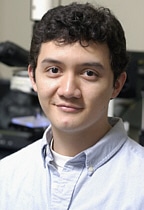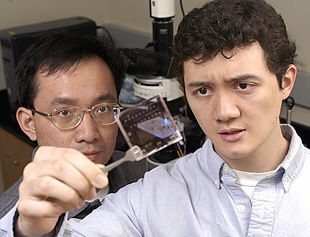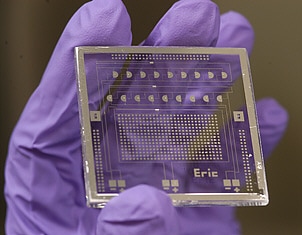Mar 22 2004
A Johns Hopkins undergraduate has constructed a new type of microchip that can move and isolate DNA and protein molecules. He believes that by linking the chip with analysis equipment, a user could identify medical ailments, monitor a patient's health or detect viruses and other biohazards before they spread.
 Eric Simone (pictured at right), a senior biomedical engineering major from the Cincinnati, Ohio, suburb of Anderson Township, fabricated and tested the chip in the lab of Jeff Tza-Huei Wang. Wang, an assistant professor in the Department of Mechanical Engineering, had already produced a biosensor chip with electrodes embedded in a straight line. Under Wang's supervision, Simone, 21, devised a biosensor chip with an innovative circular electrode design, which performed more effectively in certain bio-analytical applications.
Eric Simone (pictured at right), a senior biomedical engineering major from the Cincinnati, Ohio, suburb of Anderson Township, fabricated and tested the chip in the lab of Jeff Tza-Huei Wang. Wang, an assistant professor in the Department of Mechanical Engineering, had already produced a biosensor chip with electrodes embedded in a straight line. Under Wang's supervision, Simone, 21, devised a biosensor chip with an innovative circular electrode design, which performed more effectively in certain bio-analytical applications.
 "This chip gives us a new tool to look into biological questions," said Wang (pictured at left), who also is a faculty member of the Whitaker Biomedical Engineering Institute at Johns Hopkins. "Eric can actually interact with and manipulate individual DNA molecules." Results from Simone's work were included a paper presented at the 17th IEEE International Conference on Micro Electro Mechanical Systems, held recently in The Netherlands. The undergraduate was listed as second author on the paper.
"This chip gives us a new tool to look into biological questions," said Wang (pictured at left), who also is a faculty member of the Whitaker Biomedical Engineering Institute at Johns Hopkins. "Eric can actually interact with and manipulate individual DNA molecules." Results from Simone's work were included a paper presented at the 17th IEEE International Conference on Micro Electro Mechanical Systems, held recently in The Netherlands. The undergraduate was listed as second author on the paper.
Simone joined Wang's lab team in January 2003 and used a Provost's Undergraduate Research Award grant from the university to spend much of last summer working on his project. "The chip has tiny wires, each about one-fifth the diameter of a human hair, embedded in a circular pattern," Simone said. "When it's connected to a power source, it allows us to generate an electric field that can transport molecules to a designated area for study."
 Eric Simone, right, holds up the microchip he constructed under the supervision of Jeff Tza-Huei Wang. It has an innovative circular electrode design.
Eric Simone, right, holds up the microchip he constructed under the supervision of Jeff Tza-Huei Wang. It has an innovative circular electrode design.
PHOTO BY WILL KIRK |
The chips made by Wang and Simone take advantage of the natural negative charge possessed by DNA or a surface charge imposed on the molecules. A tiny drop of liquid containing the DNA is placed atop the chip. The electric field then guides the molecules to a designated area, where they can be analyzed under a microscope.
Simone was one of the first students to work in Wang's new lab, which focuses on micro electro mechanical systems with biological applications. "It was fascinating," Simone said. "It was like discovering a whole new field of science."
After graduating in May, Simone hopes to continue his education in a biomedical engineering doctoral program.
 A new type of microchip that can move and isolate DNA and protein molecules.
A new type of microchip that can move and isolate DNA and protein molecules.
PHOTO BY WILL KIRK |
Wang, who now has several other undergraduates working in his lab, was pleased to see how much these students can accomplish. "Once they are motivated," he said, "they do a really good job."
On March 11, Steven Knapp, university provost and senior vice president for academic affairs, hosted the 11th annual Provost's Undergraduate Research Awards ceremony, which honored the 41 winners who conducted their projects in the summer and fall of 2003. Since 1993, about 40 students each year have received PURA grants of up to $3,000 to conduct original research, some results of which have been published in professional journals. The awards, funded through a donation from the Hodson Trust, are an important part of the university's commitment to research opportunities for undergraduates.